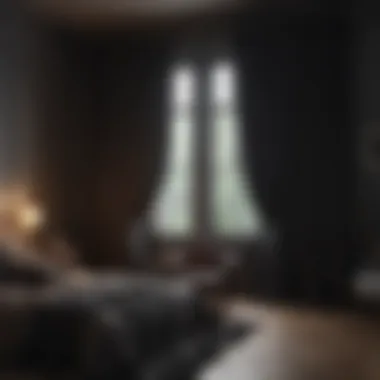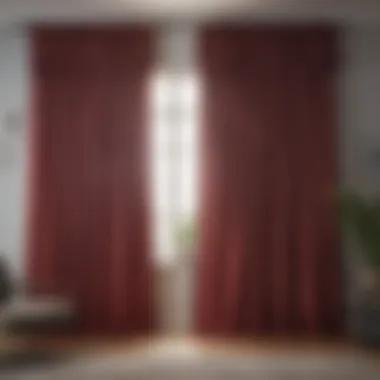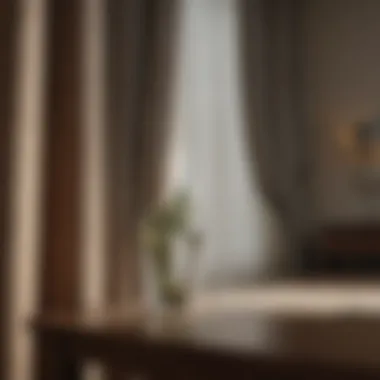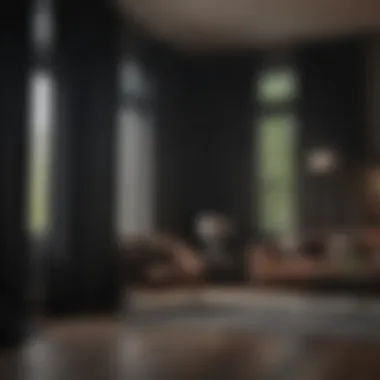Transform Your Space with Darkening Curtains


Intro
In the realm of interior design, curtains hold significant importance. They serve not only as functional elements but also contribute to the aesthetics of any room. While many might consider curtains for their decorative appeal, those designed to block light take on an even more critical role. The right pair of darkening curtains can transform your living space, offering privacy, reducing glare, and improving sleep quality. This guide aims to explore various facets of curtains that make your room dark, ranging from the types available, their materials, and precise installation options, to pairing them effectively with different decor styles.
Effectively blocking light leads to numerous benefits. A well-darkened room can enhance comfort, reduce energy costs, and create a serene environment, especially during the daytime. Understanding the nuances of darkening curtains can empower homeowners and design enthusiasts alike to make informed decisions that elevate their interiors.
In the sections that follow, we will delve deeper into the latest trends in curtain styles, practical installation tips, and how the right selection can align with energy efficiency goals.
Key Insights and Trends
Current Trends in Interior Design
Darkening curtains have gained newfound attention among homeowners and designers. Currently, there is a shift towards materials that offer both style and functionality. Fabrics such as blackout polyester and linen blends not only block light but also align with sustainability efforts in design.
Homeowners are increasingly opting for layered looks. This involves pairing sheer curtains with heavier blackout options. Such combinations provide flexibility, allowing for varying light control throughout the day. Additionally, colors like deep navy, rich burgundy, and classic gray are becoming favored choices, complementing both modern and traditional decor themes.
Practical Tips and How-To Guides
Step-by-step Guide for Choosing Darkening Curtains
- Determine your needs: Assess how much light you want to block and for which rooms. A bedroom may require heavier coverage compared to a living area.
- Select the material: Consider fabrics that provide complete darkness. Blackout polyester offers a cost-effective solution, while high-end options like velvet add luxury.
- Choose a color and style: Match the curtains to your existing decor. A bold color can serve as a statement piece, while neutral tones blend seamlessly.
- Measure appropriately: Accurate measurements ensure a proper fit. Measure both the width and length to avoid any mishaps during installation.
- Installation: Decide between rods, tracks, or corded systems. Rods are more straightforward while tracked systems provide a sleek, modern look.
- Layering options: If desired, consider layering with sheer curtains to create versatility. This approach allows for light control while maintaining privacy.
"The right curtains can completely change the energy of a room, providing not just darkness but also comfort and style."
Understanding these insights and tips can guide readers in crafting a space that reflects both their personal style and practical needs.
Understanding Light Control in Interior Spaces
Light has a profound impact on the feel and functionality of any space. In interior design, managing natural and artificial light is essential for creating a comfortable and aesthetically pleasing environment. This article emphasizes how proper light control can affect various aspects of interior spaces, from the overall ambiance to energy efficiency.
The Importance of Light Management
Effective light management allows homeowners to optimize their living spaces. It is crucial for several reasons:
- Mood Enhancement: The right light control can elevate or diminish the mood of a room. Soft, diffused light can create a calm and serene atmosphere, while brighter light serves to energize.
- Comfort and Usability: Managing light can enhance comfort. Excessive glare or direct sunlight can create uncomfortable conditions, particularly in work or relaxation spaces.
- Energy Efficiency: Strategic use of light can reduce energy costs. By controlling when and how light enters a room, individuals can rely less on artificial lighting, thus saving electricity.
Light management is not just about blocking sunlight; it involves a thoughtful balance to create spaces that feel right for their intended use.
How Light Affects Room Atmosphere
The atmosphere of a room is deeply intertwined with how light interacts with its elements. Several factors can influence this:
- Natural Light Sources: The placement of windows plays a significant role in how light spills into a room. High ceilings, large windows, and south-facing exposures often lead to brighter interiors. However, it is essential to consider how this affects privacy and temperature.
- Color and Reflection: Colors react differently under varying light conditions. Dark colors absorb light, which can make a room feel smaller. Light colors, in contrast, reflect light, often making a room feel more open and airy.
- Type of Lighting Fixtures: The kind of light fixtures used will also shape the feel of the room. Warm light can create a cozy atmosphere, while cool light may feel clean and modern.
"Lighting is not just a functional element, it transforms spaces into places."
Understanding the nuances of how light operates within a space can significantly enhance the design approach and ensure that the choice of curtains aligns with the overall intention.
Types of Curtains for Darkening Rooms
Darkening curtains are essential for homeowners seeking to optimally control light within their living spaces. The right type of curtain can significantly affect how a room feels and functions. When considering the types of curtains available, it is important to think about specific elements like functionality, aesthetics, and energy efficiency. Selecting curtains that effectively darken a room can enhance privacy, improve sleep quality, and contribute to energy savings, making them a smart choice for various settings.
Blackout Curtains Explained
Blackout curtains are designed to block most, if not all, incoming light. Their unique construction often involves layers of dense fabric coupled with a lining that absorbs sunlight. This makes them particularly effective in bedrooms, home theaters, and any area where complete darkness is desired.
These curtains come in various colors and styles, allowing for decoration coherence while performing their primary function. When shopping for blackout curtains, it is essential to check for the following:
- Thickness: Look for heavier fabrics; they typically offer better light-blocking capabilities.
- Lining: An extra layer of fabric can enhance their effectiveness.
- Sizing: Curtains that extend beyond the window frame prevent light leakage from the sides.


"Blackout curtains can lower energy bills by keeping heat inside during winter and blocking the sun in summer."
With the right setup, blackout curtains transform a room into a serene, dark environment ideal for sleep or relaxation.
Thermal Curtains for Energy Efficiency
Thermal curtains serve a dual purpose. They not only block light but also insulate windows. Constructed with special materials, these curtains trap air between the window and the interior of the room. This layer of insulation contributes to a more stable indoor climate, reducing energy costs associated with heating and cooling.
Key aspects of thermal curtains include:
- Material: Look for curtains labeled as thermal or energy-efficient.
- Fit: The effectiveness increases when these curtains fit snugly against the window without gaps.
- Blackout Option: Some thermal curtains also feature blackout qualities, combining light blocking and insulation for additional benefits.
In areas with extreme temperatures, thermal curtains can contribute to year-round comfort while providing a stylish element to the room.
Light-Filtering Curtains vs. Darkening Curtains
The choice between light-filtering curtains and darkening curtains is fundamental in designing a space according to specific needs.
Light-filtering curtains allow a degree of natural light to enter, creating a softer ambiance. They are often made from sheer materials that diffuse sunlight, making them suitable for living rooms or dining areas. However, they do not provide the same level of darkness as blackout or thermal curtains.
In contrast, darkening curtains, which include blackout and thermal varieties, are meant to minimize light penetration. This distinction is important:
- Functionality: Assess what you need the curtains for; whether it is for light control, privacy, or ambiance.
- Room Use: Living spaces may benefit from light-filtering curtains, whereas bedrooms might require complete darkness.
- Style Choices: Light-filtering options can brighten a room while still offering some privacy, which may be desirable in shared spaces.
Ultimately, the right choice will depend on individual preferences and functional needs. A discerning homeowner can combine different types of curtains across various rooms, tailoring the light exposure to fit each space's purpose.
Material Considerations for Darkening Curtains
When selecting curtains to effectively darken your room, the material is one of the most important factors. The type of fabric used determines not only how much light you can block but also influences the overall aesthetic and functionality of the curtains. Understanding the materials available can guide homeowners and design enthusiasts in making informed decisions that align with their specific needs.
Fabric Types and Light Blocking Qualities
Different fabric types have various light-blocking qualities. Common materials include polyester, cotton, and linen.
- Polyester is a prevalent choice due to its durability and ability to block light effectively. It is often treated to enhance blackout features, making it an excellent option for bedrooms and media rooms.
- Cotton offers a natural look but typically allows some light to filter through unless it is specially woven for darkness. Its breathability can also impact room temperature.
- Linen is stylish and airy but may not provide the necessary darkness unless layered with other materials.
When considering the fabric, also look for those labeled as blackout or blockout. These fabrics may contain special linings or coatings that improve their light-blocking performance. It is essential to balance aesthetics with functionality.
The Role of Weave and Density
The weave and density of the fabric also affect the curtain's effectiveness in blocking light. A tighter weave will generally trap more light, while a looser weave can let light penetrate more easily.
- Density refers to how thick the material is. Heavier fabrics like velvet or thick polyester are more effective at blocking light compared to lighter ones.
- Weave pattern matters too. A smooth, tight weave is preferable for maximum light control compared to a textured or open weave.
The combination of these elements will dictate how effectively the curtains perform. Homeowners should inspect the fabric closely and consider swatches in their own light conditions to see how they behave at different times of day.
Installation Options for Effective Darkening
When choosing curtains that block light, how you install them is just as critical as the type you select. A poor installation can lead to light gaps, negating the benefits of the best darkening curtains. Thus, understanding various installation options is essential to achieving an optimal darkening effect. This section outlines the key factors involved in curtain installation, focusing on hardware choices and techniques that ensure effective light blocking.
Choosing the Right Rods and Hardware
Selecting the right rods and hardware for your darkening curtains is crucial. The type of rod can impact both aesthetics and functionality. Consider the weight of the curtains; heavier fabrics necessitate sturdier rods and brackets. An adjustable curtain rod can provide flexibility in fitting your space.
In addition to strength, the finish of the hardware should match your decor style. For instance, brushed nickel rods complement contemporary spaces, while antique brass suits traditional designs. Adding finials can also enhance visual interest, making the hardware a decorative feature in its own right.
Types of hardware to consider:
- Traverse rods: Ideal for curtains that slide open and closed.
- Decorative rods: A visual statement, great for lighter curtains that do not require heavy support.
- Continuous-loop chain systems: Perfect for blackout curtains, offering smooth operation.


Mounting Techniques for Optimal Coverage
Correct mounting techniques play a significant role in covering windows effectively. Curtains should be installed to extend beyond the window frame. This prevents light from sneaking in where curtains do not reach. Aim for a minimum of four inches beyond the width of the window. This simple adjustment can vastly improve darkness in the room.
Further, mounting height should be carefully considered. Installing rods higher than the window frame can create an illusion of height, while also providing fuller coverage when the curtains are closed. Ideally, mount the rod about six inches above the window trim.
Additionally, you can use cleat or tie-back systems to pull curtains away from windows during the day, allowing more light in while keeping the fabric neatly secured.
"The right installation setup not only maximizes light control but also serves as an integral part of your room's design aesthetic."
Design Considerations When Selecting Curtains
Selecting the right curtains goes beyond just their functional capabilities. It requires a thoughtful consideration of design elements that contribute to the overall aesthetic and feel of a room. Design considerations influence the ambiance, functionality, and even how light interacts with a space. A careful selection can complement or enhance existing decor, offering not only a practical solution for managing light but also elevating the entire room's appearance.
Color and Pattern Selection
The choice of color and patterns in curtain design plays a crucial role in shaping the mood of a room. Colors evoke emotions and set the tone for any interior space.
- Neutral Colors: Opting for neutral hues like beige, gray, or white can create a calm and serene atmosphere. They allow for flexibility in changing decor styles without clashing.
- Bold Colors: Rich tones such as navy, emerald green, or burgundy can serve as statement pieces. They add depth and can energize a space.
- Patterns: Patterns, ranging from geometric to floral, can add visual interest. However, when selecting, consider the existing patterns in the room to avoid overwhelming the space. Floral patterns may enhance a cozy room, while geometric designs suit more modern settings.
Choosing the right color and pattern is also about understanding how they interact with light. Dark colors absorb more light, which contributes to a darker room, while lighter shades may reflect light and lessen the effectiveness of darkening curtains.
Coordinating Curtains with Room Decor
Integrating curtains seamlessly into the overall decor of a room is essential. Thoughtful coordination contributes to a harmonious visual experience.
- Style Alignment: Consider the style of the room. For a contemporary setting, sleek, minimalistic designs work best, while traditional rooms may benefit from more ornate curtain details.
- Texture Matching: The texture of curtain fabric should correlate with the other materials in the room. For instance, if the furnishings are soft and plush, choose fabrics with a similar tactile quality. This approach provides uniformity in sensory experiences.
- Functional Elements: Curtains not only contribute to aesthetics but also to the functionality of the room. Ensure they are practical for the intended purpose. Lighter colors may suit spaces that need more natural light during the day, while darker curtains are preferable for bedrooms needing darkness at night.
While selecting curtains, remember these guidelines:
- Maintain a balance between form and function.
- Consider the time of day when deciding on color saturation and fabric opacity.
- Assess how curtains might frame windows to draw attention or blend in with walls.
"Curtains are not just pieces of fabric but are vital components of interior architecture, influencing light, mood, and overall design harmony."
Emphasizing these design considerations ensures your selection not only fulfills the primary purpose of darkening a room but also enhances its style and coherence.
Benefits of Using Darkening Curtains
Darkening curtains serve more than just an aesthetic purpose in a room. Their primary function is to block out light, but the benefits extend beyond basic light control. This section will outline the significance of these curtains in creating a comfortable and efficient living space. Considerations span from energy savings to improved privacy and security, as well as contributions to better sleep quality. The choice of darkening curtains can fundamentally influence how a space feels and functions.
Energy Savings and Efficiency
Utilizing darkening curtains can lead to noticeable energy savings. They help to insulate a room by reducing heat transfer. In the summer, these curtains keep the heat out, leading to lower air conditioning costs. In the winter, they provide an extra layer that keeps warmth inside, thus minimizing heating expenses. The impact is especially significant for homeowners in regions with extreme climate conditions, where energy costs can be considerable.
By blocking excessive sunlight, these curtains help in maintaining a stable indoor temperature. This results in less reliance on HVAC systems, ultimately contributing to environmental sustainability. Homeowners are not just making their living spaces comfortable; they are also reducing their carbon footprint.
"Installing darkening curtains can yield substantial savings on energy bills while providing comfort."
Enhanced Privacy and Security
Privacy is a crucial aspect of any living space. Darkening curtains provide a practical solution for homeowners wishing to shield themselves from prying eyes. With the right choice of fabric, these curtains can effectively obscure visibility, creating a secure feeling even in densely populated areas.
Additionally, darkening curtains can act as a deterrent against potential intruders. Beyond the aesthetic appeal, they serve a protective function by making it harder to see inside the home. This added layer of security contributes to peace of mind for residents, knowing their personal space remains confidential.
Better Sleep Quality
Quality sleep is vital for overall well-being. Darkening curtains play a key role in creating an optimal sleep environment. By blocking artificial light and early morning sun, they help maintain a conducive atmosphere for rest. This is particularly important for individuals who work night shifts or live in urban settings where external light can be intrusive.
A well-darkened room reduces disturbances and enhances one's ability to fall asleep. By controlling light levels effectively, darkening curtains help to regulate the body's internal clock, promoting healthier sleep patterns. Homeowners who prioritize sleep should consider the advantages darkening curtains present in crafting their ideal sleeping space.


Maintaining and Caring for Darkening Curtains
Darkening curtains provide significant benefits for any room, including energy efficiency, privacy, and improved sleep quality. However, their effectiveness largely depends on proper maintenance. Caring for these curtains helps preserve their functionality and appearance. Understanding how to maintain them ensures they last longer and perform their intended role effectively.
Cleaning and Washing Requirements
Proper cleaning of darkening curtains is crucial. Usually, manufacturers provide specific care instructions. Generally, these curtains can be machine washed or dry cleaned, but it varies by fabric type. Here are some key points to consider:
- Check the label for care instructions. This provides guidance on water temperature and washing methods.
- Dust regularly using a soft brush attachment on your vacuum. This will prevent dirt buildup.
- If washing, use a gentle cycle with mild detergent. Avoid strong chemicals that could degrade fabric.
- When air drying, avoid direct sunlight, as this can fade colors or affects the fabric.
Regular maintenance not only extends the lifespan of your curtains but also keeps them looking aesthetically pleasing.
Long-Term Care Tips
To ensure the longevity of darkening curtains, attention to long-term care is necessary. Here are noteworthy strategies:
- Avoid heavy sunlight exposure when possible. If you can, pull them open during the day to minimize fading.
- Rotate them if they are near windows. This allows even exposure and prevents uneven wear.
- Store properly when not in use. If you decide to take them down, ensure they are clean, dry, and packed in breathable fabric.
- Inspect for damage at regular intervals. If you notice any loose threads or wear, repairing this immediately can prevent larger issues in the future.
By focusing on these maintenance aspects, homeowners and design enthusiasts will ensure their darkening curtains remain functional and visually appealing for years to come.
Exploring the Market: Where to Buy Darkening Curtains
When seeking darkening curtains, understanding the available purchasing options is crucial. Your choice can significantly influence not only the quality of the curtains but also the overall shopping experience. The market offers a variety of platforms for purchasing these essential home accessories. Each avenue presents its own advantages and considerations, and knowing the differences can help you make a well-informed decision.
Online Retailers vs. Brick-and-Mortar Stores
In today's digital age, online retailers have gained immense popularity. They provide a vast selection of darkening curtains at your fingertips. Websites such as Amazon, Wayfair, and IKEA offer myriad styles, sizes, and prices. Furthermore, shopping online allows for easy price comparisons and access to customer reviews, which can aid in evaluating quality and suitability.
However, shopping in brick-and-mortar stores also holds merit. Stores like Home Depot and Target allow you to physically examine the fabric and assess the color and texture in person. This tactile experience can be valuable, as lighting conditions can alter how a fabric appears online.
Consider the following when choosing between these two options:
- Convenience: Online shopping can be done anytime, while physical stores have set hours.
- Variety: Online platforms often outpace local stores in available options.
- Immediate Gratification: In-store purchases allow you to take curtains home immediately, avoiding shipping delays.
Ultimately, the choice between online and brick-and-mortar shopping hinges on personal preference and particular needs.
What to Look for When Shopping
When browsing for darkening curtains, specific factors should guide your selection to ensure they meet your requirements. Pay attention to:
- Material: Different fabrics offer varying levels of light-blocking capabilities. Polyester and velvet are commonly used for their durability and effectiveness.
- Color: Darker colors generally absorb more light. However, consider your overall room decor when making a choice.
- Size and Fit: Measure your windows carefully, accounting for rod length and installation type. Curtains should ideally extend beyond the window frame for optimal coverage.
- Features: Look for additional benefits such as thermal insulation or noise reduction. Some curtains combine these features with effective light blocking.
Remember, the right curtains can enhance not only your interior's look but also its functionality.
By considering these elements, you can make educated decisions that will align with your aesthetic preferences and practical needs, resulting in a more satisfying purchase.
Assessing Your Needs: When to Use Darkening Curtains
In the quest for optimal interior living spaces, understanding when to incorporate darkening curtains is critical. These curtains serve more than merely blocking light; they play a significant role in enhancing comfort, privacy, and energy efficiency. By assessing your needs before making a selection, you will be in a better position to create spaces that align with your lifestyle and preferences.
Determining Room Functionality
The core factor in deciding to use darkening curtains lies in the functionality of the room. Different spaces serve varied purposes, and the choice of curtain must reflect that. For instance, bedrooms benefit immensely from darkening curtains, contributing to better sleep quality by blocking external light sources.
In contrast, leisure areas like living rooms may require a balance between light control and ambiance. In these places, using lighter fabrics in combination with blackout lining can regulate brightness while maintaining an inviting atmosphere. Assess what activities you pursue in each room. If relaxation or concentration is a priority, darkening curtains should be at the forefront of your choices.
Considering Local Climate and Seasonal Changes
The local climate is another aspect to reflect on when considering darkening curtains. In regions with extreme sunlight, like desert areas, using blackout curtains can keep interiors cool, reducing the reliance on air conditioning, thus enhancing energy efficiency.
Seasonal changes also affect the need for darkening curtains. During the summer months, light guidance is vital to keep spaces cool, while in winter, maintaining heat may become a necessity. Some curtains offer thermal properties that help insulate your home, ensuring comfort. Always take into account both the existing weather patterns and anticipated seasonal variations in your locale.
"Understanding your environment and how it interacts with your living space is pivotal in optimizing light control."
By methodically assessing room functionality and local climate, you can make informed decisions. Darkening curtains must not just block light; they should be an integral part of creating a comfortable, functional environment.



